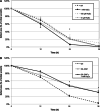Adipose-derived stem cells and keratinocytes in a chronic wound cell culture model: the role of hydroxyectoine
- PMID: 23841674
- PMCID: PMC7950684
- DOI: 10.1111/iwj.12120
Adipose-derived stem cells and keratinocytes in a chronic wound cell culture model: the role of hydroxyectoine
Abstract
Chronic wounds represent a major socio-economic problem in developed countries today. Wound healing is a complex biological process. It requires a well-orchestrated interaction of mediators, resident cells and infiltrating cells. In this context, mesenchymal stem cells and keratinocytes play a crucial role in tissue regeneration. In chronic wounds these processes are disturbed and cell viability is reduced. Hydroxyectoine (HyEc) is a membrane protecting osmolyte with protein and macromolecule stabilising properties. Adipose-derived stem cells (ASC) and keratinocytes were cultured with chronic wound fluid (CWF) and treated with HyEc. Proliferation was investigated using MTT test and migration was examined with transwell-migration assay and scratch assay. Gene expression changes of basic fibroblast growth factor (b-FGF), vascular endothelial growth factor (VEGF), matrix metalloproteinases-2 (MMP-2) and MMP-9 were analysed by quantitative real-time polymerase chain reaction (qRT-PCR). CWF significantly inhibited proliferation and migration of keratinocytes. Addition of HyEc did not affect these results. Proliferation capacity of ASC was not influenced by CWF whereas migration was significantly enhanced. HyEc significantly reduced ASC migration. Expression of b-FGF, VEGF, MMP-2 and MMP-9 in ASC, and b-FGF, VEGF and MMP-9 in keratinocytes was strongly induced by chronic wound fluid. HyEc enhanced CWF induced gene expression of VEGF in ASC and MMP-9 in keratinocytes. CWF negatively impaired keratinocyte function, which was not influenced by HyEc. ASC migration was stimulated by CWF, whereas HyEc significantly inhibited migration of ASC. CWF induced gene expression of VEGF in ASC and MMP-9 in keratinocytes was enhanced by HyEc, which might partly be explained by an RNA stabilising effect of HyEc.
Keywords: Adipose-derived stem cells; Chronic wound; Gene expression; Hydroxyectoine; Keratinocytes; Migration; Proliferation; Wound fluid; Wound healing.
© 2013 The Authors. International Wound Journal © 2013 Medicalhelplines.com Inc and John Wiley & Sons Ltd.
Figures





Similar articles
-
Acute and chronic wound fluids inversely influence adipose-derived stem cell function: molecular insights into impaired wound healing.Int Wound J. 2015 Feb;12(1):10-6. doi: 10.1111/iwj.12039. Epub 2013 Mar 13. Int Wound J. 2015. PMID: 23490259 Free PMC article.
-
Acute and chronic wound fluids influence keratinocyte function differently.Int Wound J. 2015 Apr;12(2):143-9. doi: 10.1111/iwj.12069. Epub 2013 Mar 21. Int Wound J. 2015. PMID: 23517467 Free PMC article.
-
Differential response of human adipose tissue-derived mesenchymal stem cells, dermal fibroblasts, and keratinocytes to burn wound exudates: potential role of skin-specific chemokine CCL27.Tissue Eng Part A. 2014 Jan;20(1-2):197-209. doi: 10.1089/ten.TEA.2013.0123. Epub 2013 Oct 2. Tissue Eng Part A. 2014. PMID: 23980822 Free PMC article.
-
Novel non-angiogenic role for mesenchymal stem cell-derived vascular endothelial growth factor on keratinocytes during wound healing.Cytokine Growth Factor Rev. 2018 Dec;44:69-79. doi: 10.1016/j.cytogfr.2018.11.002. Epub 2018 Nov 15. Cytokine Growth Factor Rev. 2018. PMID: 30470511 Review.
-
Implications of Extracellular Matrix Production by Adipose Tissue-Derived Stem Cells for Development of Wound Healing Therapies.Int J Mol Sci. 2017 May 31;18(6):1167. doi: 10.3390/ijms18061167. Int J Mol Sci. 2017. PMID: 28561757 Free PMC article. Review.
Cited by
-
Long-term follow-up and exploration of the mechanism of stromal vascular fraction gel in chronic wounds.Stem Cell Res Ther. 2023 Jun 19;14(1):163. doi: 10.1186/s13287-023-03389-2. Stem Cell Res Ther. 2023. PMID: 37337292 Free PMC article.
-
Potential applications of stress solutes from extremophiles in protein folding diseases and healthcare.Extremophiles. 2016 May;20(3):251-9. doi: 10.1007/s00792-016-0828-8. Epub 2016 Apr 12. Extremophiles. 2016. PMID: 27071404 Review.
-
Epithelial differentiation of human adipose-derived stem cells (hASCs) undergoing three-dimensional (3D) cultivation with collagen sponge scaffold (CSS) via an indirect co-culture strategy.Stem Cell Res Ther. 2020 Mar 31;11(1):141. doi: 10.1186/s13287-020-01645-3. Stem Cell Res Ther. 2020. PMID: 32234069 Free PMC article.
-
Therapeutic applications of adipose cell-free derivatives: a review.Stem Cell Res Ther. 2020 Jul 22;11(1):312. doi: 10.1186/s13287-020-01831-3. Stem Cell Res Ther. 2020. PMID: 32698868 Free PMC article. Review.
-
Feedback Activation of Basic Fibroblast Growth Factor Signaling via the Wnt/β-Catenin Pathway in Skin Fibroblasts.Front Pharmacol. 2017 Feb 3;8:32. doi: 10.3389/fphar.2017.00032. eCollection 2017. Front Pharmacol. 2017. PMID: 28217097 Free PMC article.
References
-
- Gillitzer R, Goebeler M. Chemokines in cutaneous wound healing. J Leukoc Biol 2001;69:513–21. - PubMed
-
- Akino K, Mineda T, Akita S. Early cellular changes of human mesenchymal stem cells and their interaction with other cells. Wound Repair Regen 2005;13:434–40. - PubMed
-
- Baker EA, Leaper DJ. Proteinases, their inhibitors, and cytokine profiles in acute wound fluid. Wound Repair Regen 2000;8:392–8. - PubMed
-
- Trengove NJ, Stacey MC, MacAuley S, Bennett N, Gibson J, Burslem F, Murphy G, Schultz G. Analysis of the acute and chronic wound environments: the role of proteases and their inhibitors. Wound Repair Regen 1999;7:442–52. - PubMed
Publication types
MeSH terms
Substances
LinkOut - more resources
Full Text Sources
Other Literature Sources
Miscellaneous

